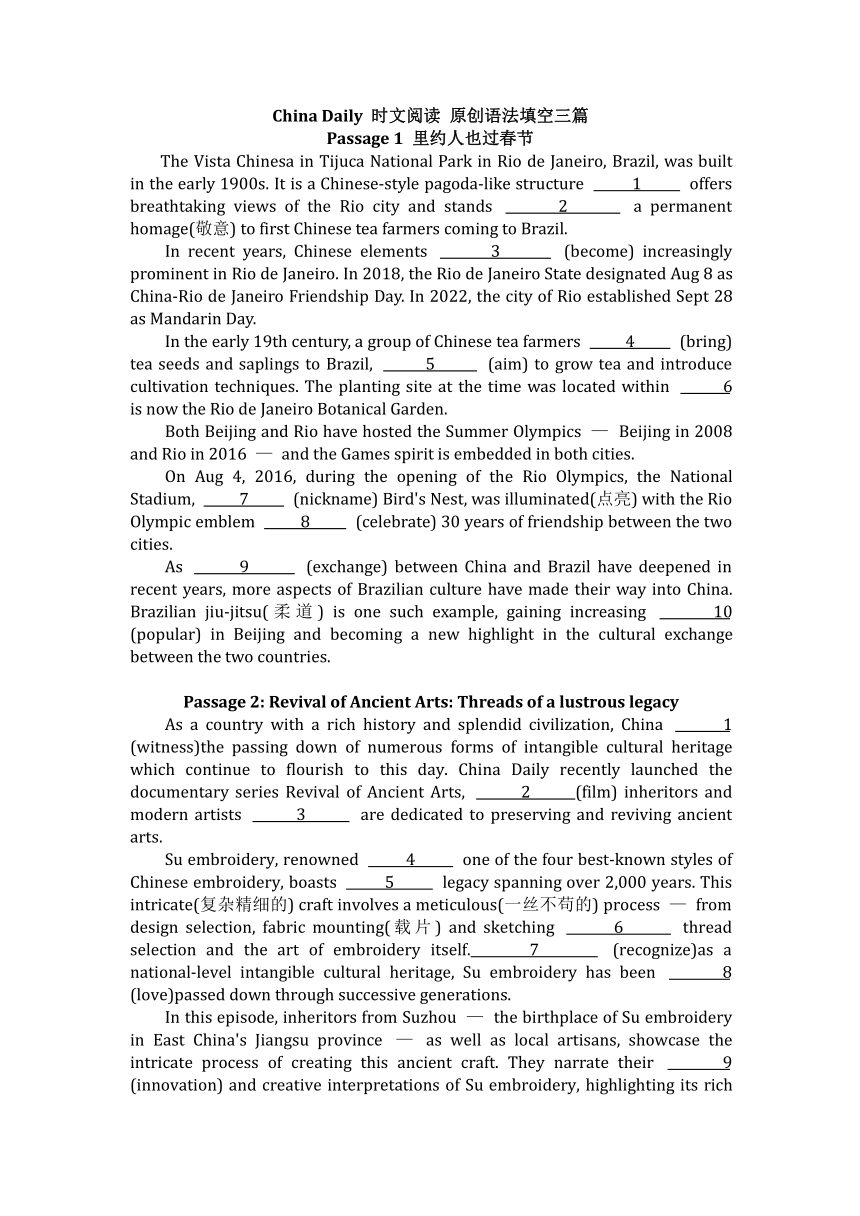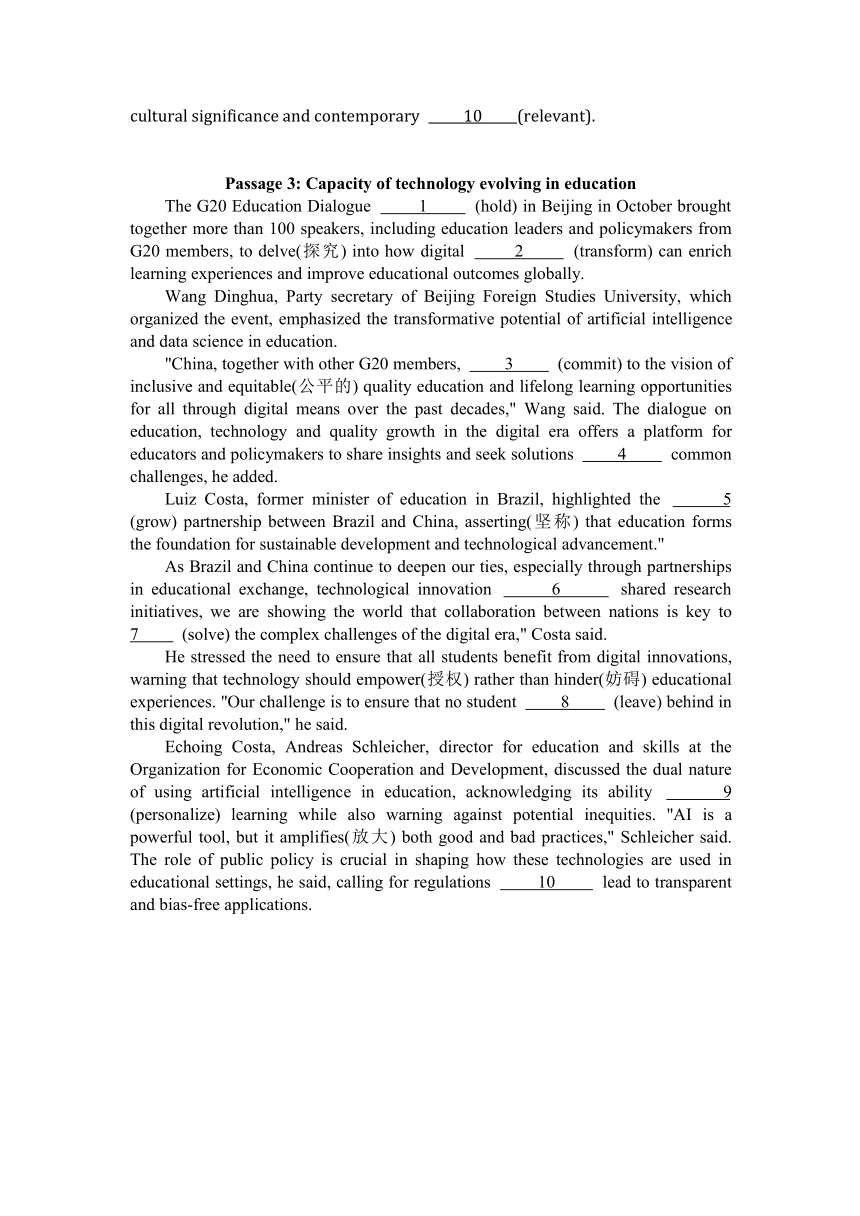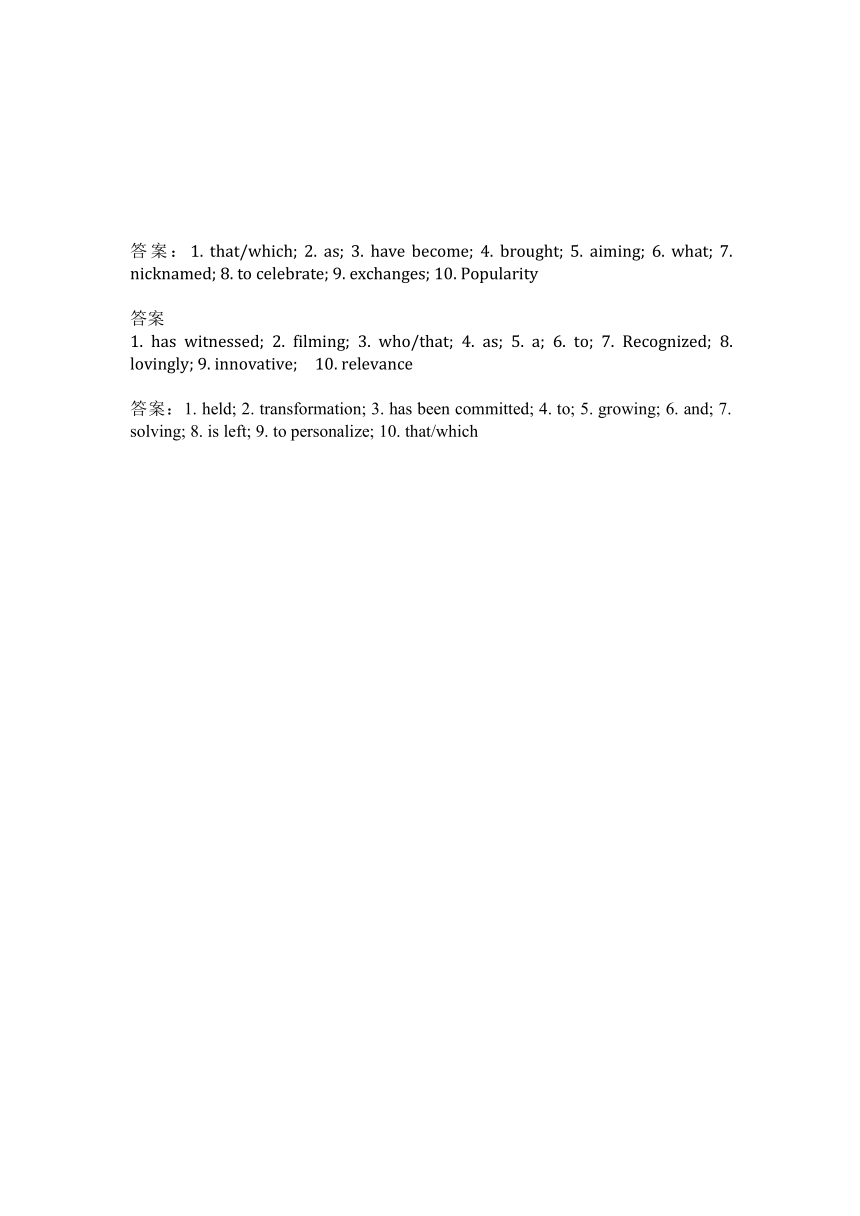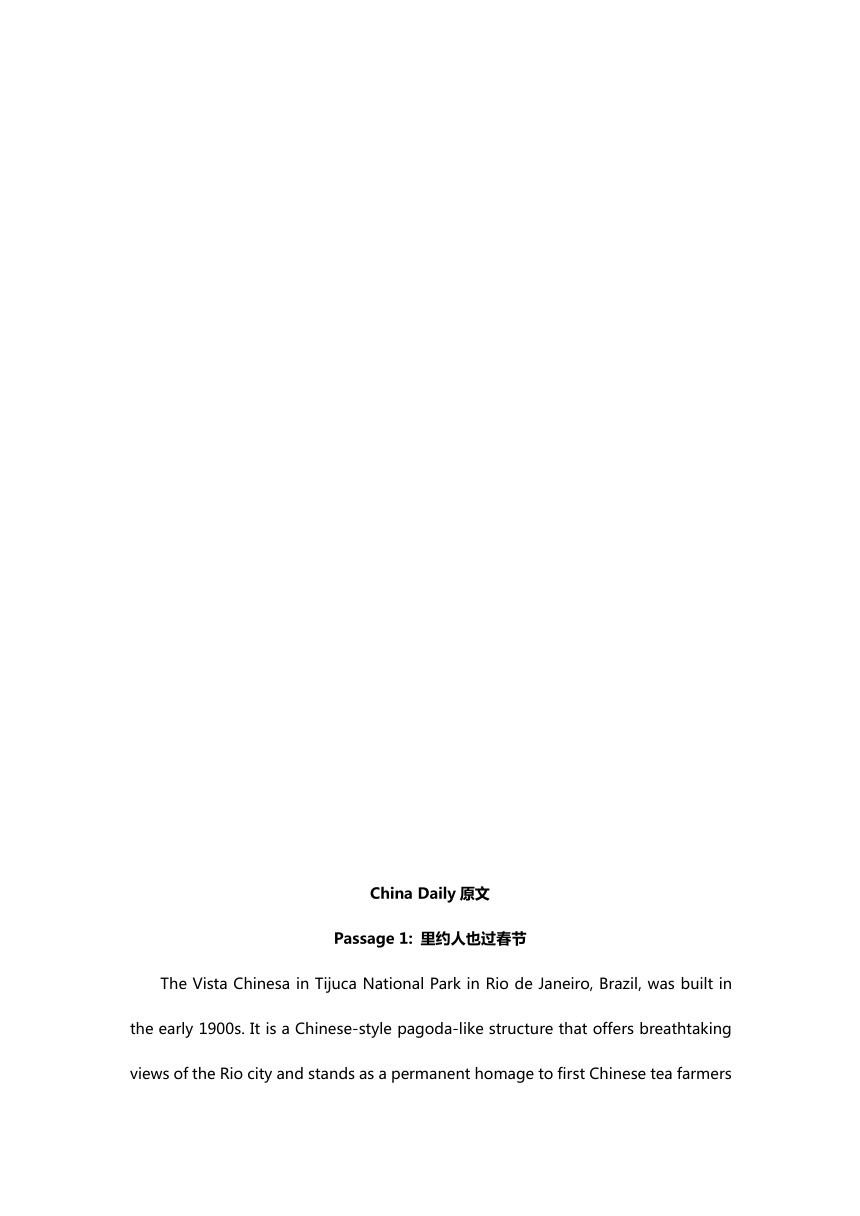2025届高三英语二轮复习:China Daily 时文阅读改编语法填空三篇 练习(含答案)
文档属性
| 名称 | 2025届高三英语二轮复习:China Daily 时文阅读改编语法填空三篇 练习(含答案) |  | |
| 格式 | docx | ||
| 文件大小 | 25.9KB | ||
| 资源类型 | 教案 | ||
| 版本资源 | 人教版(2019) | ||
| 科目 | 英语 | ||
| 更新时间 | 2025-01-09 17:03:33 | ||
图片预览




文档简介
China Daily 时文阅读 原创语法填空三篇
Passage 1 里约人也过春节
The Vista Chinesa in Tijuca National Park in Rio de Janeiro, Brazil, was built in the early 1900s. It is a Chinese-style pagoda-like structure 1 offers breathtaking views of the Rio city and stands 2 a permanent homage(敬意) to first Chinese tea farmers coming to Brazil.
In recent years, Chinese elements 3 (become) increasingly prominent in Rio de Janeiro. In 2018, the Rio de Janeiro State designated Aug 8 as China-Rio de Janeiro Friendship Day. In 2022, the city of Rio established Sept 28 as Mandarin Day.
In the early 19th century, a group of Chinese tea farmers 4 (bring) tea seeds and saplings to Brazil, 5 (aim) to grow tea and introduce cultivation techniques. The planting site at the time was located within 6 is now the Rio de Janeiro Botanical Garden.
Both Beijing and Rio have hosted the Summer Olympics — Beijing in 2008 and Rio in 2016 — and the Games spirit is embedded in both cities.
On Aug 4, 2016, during the opening of the Rio Olympics, the National Stadium, 7 (nickname) Bird's Nest, was illuminated(点亮) with the Rio Olympic emblem 8 (celebrate) 30 years of friendship between the two cities.
As 9 (exchange) between China and Brazil have deepened in recent years, more aspects of Brazilian culture have made their way into China. Brazilian jiu-jitsu(柔道) is one such example, gaining increasing 10 (popular) in Beijing and becoming a new highlight in the cultural exchange between the two countries.
Passage 2: Revival of Ancient Arts: Threads of a lustrous legacy
As a country with a rich history and splendid civilization, China 1 (witness)the passing down of numerous forms of intangible cultural heritage which continue to flourish to this day. China Daily recently launched the documentary series Revival of Ancient Arts, 2 (film) inheritors and modern artists 3 are dedicated to preserving and reviving ancient arts.
Su embroidery, renowned 4 one of the four best-known styles of Chinese embroidery, boasts 5 legacy spanning over 2,000 years. This intricate(复杂精细的) craft involves a meticulous(一丝不苟的) process — from design selection, fabric mounting(载片) and sketching 6 thread selection and the art of embroidery itself. 7 (recognize)as a national-level intangible cultural heritage, Su embroidery has been 8 (love)passed down through successive generations.
In this episode, inheritors from Suzhou — the birthplace of Su embroidery in East China's Jiangsu province — as well as local artisans, showcase the intricate process of creating this ancient craft. They narrate their 9 (innovation) and creative interpretations of Su embroidery, highlighting its rich cultural significance and contemporary 10 (relevant).
Passage 3: Capacity of technology evolving in education
The G20 Education Dialogue 1 (hold) in Beijing in October brought together more than 100 speakers, including education leaders and policymakers from G20 members, to delve(探究) into how digital 2 (transform) can enrich learning experiences and improve educational outcomes globally.
Wang Dinghua, Party secretary of Beijing Foreign Studies University, which organized the event, emphasized the transformative potential of artificial intelligence and data science in education.
"China, together with other G20 members, 3 (commit) to the vision of inclusive and equitable(公平的) quality education and lifelong learning opportunities for all through digital means over the past decades," Wang said. The dialogue on education, technology and quality growth in the digital era offers a platform for educators and policymakers to share insights and seek solutions 4 common challenges, he added.
Luiz Costa, former minister of education in Brazil, highlighted the 5 (grow) partnership between Brazil and China, asserting(坚称) that education forms the foundation for sustainable development and technological advancement."
As Brazil and China continue to deepen our ties, especially through partnerships in educational exchange, technological innovation 6 shared research initiatives, we are showing the world that collaboration between nations is key to 7 (solve) the complex challenges of the digital era," Costa said.
He stressed the need to ensure that all students benefit from digital innovations, warning that technology should empower(授权) rather than hinder(妨碍) educational experiences. "Our challenge is to ensure that no student 8 (leave) behind in this digital revolution," he said.
Echoing Costa, Andreas Schleicher, director for education and skills at the Organization for Economic Cooperation and Development, discussed the dual nature of using artificial intelligence in education, acknowledging its ability 9 (personalize) learning while also warning against potential inequities. "AI is a powerful tool, but it amplifies(放大) both good and bad practices," Schleicher said. The role of public policy is crucial in shaping how these technologies are used in educational settings, he said, calling for regulations 10 lead to transparent and bias-free applications.
答案:1. that/which; 2. as; 3. have become; 4. brought; 5. aiming; 6. what; 7. nicknamed; 8. to celebrate; 9. exchanges; 10. Popularity
答案
1. has witnessed; 2. filming; 3. who/that; 4. as; 5. a; 6. to; 7. Recognized; 8. lovingly; 9. innovative; 10. relevance
答案:1. held; 2. transformation; 3. has been committed; 4. to; 5. growing; 6. and; 7. solving; 8. is left; 9. to personalize; 10. that/which
China Daily原文
Passage 1: 里约人也过春节
The Vista Chinesa in Tijuca National Park in Rio de Janeiro, Brazil, was built in the early 1900s. It is a Chinese-style pagoda-like structure that offers breathtaking views of the Rio city and stands as a permanent homage to first Chinese tea farmers coming to Brazil.
In recent years, Chinese elements have become increasingly prominent in Rio de Janeiro. In 2018, the Rio de Janeiro State designated Aug 8 as China-Rio de Janeiro Friendship Day. In 2022, the city of Rio established Sept 28 as Mandarin Day. In Rio de Janeiro State, Spring Festival, or Chinese New Year, is recognized as an official holiday.
In the early 19th century, a group of Chinese tea farmers brought tea seeds and saplings to Brazil, aiming to grow tea and introduce cultivation techniques. The planting site at the time was located within what is now the Rio de Janeiro Botanical Garden.
Both Beijing and Rio have hosted the Summer Olympics — Beijing in 2008 and Rio in 2016 — and the Games spirit is embedded in both cities.
On Aug 4, 2016, during the opening of the Rio Olympics, the National Stadium, nicknamed Bird's Nest, was illuminated with the Rio Olympic emblem to celebrate 30 years of friendship between the two cities.
As exchanges between China and Brazil have deepened in recent years, more aspects of Brazilian culture have made their way into China. Brazilian jiu-jitsu is one such example, gaining increasing popularity in Beijing and becoming a new highlight in the cultural exchange between the two countries.
Brazil was the guest of honor for the Beijing International Film Festival, held in April, as China and Brazil celebrate 50 years of diplomatic ties this year. Brazilian film director Carlos Saldanha was invited to serve as a juror for the Tiantan Award.
"Movies can bridge cultures by speaking to the universal human experience. I would be thrilled to collaborate with any Chinese filmmaker passionate about creating something that resonates not only with our countries but with audiences worldwide," Saldanha said.
Passage 2: Revival of Ancient Arts: Threads of a lustrous legacy
As a country with a rich history and splendid civilization, China has witnessed the passing down of numerous forms of intangible cultural heritage which continue to flourish to this day. China Daily recently launched the documentary series Revival of Ancient Arts, filming inheritors and modern artists who are dedicated to preserving and reviving ancient arts.
Su embroidery, renowned as one of the four best-known styles of Chinese embroidery, boasts a legacy spanning over 2,000 years. This intricate craft involves a meticulous process — from design selection, fabric mounting and sketching to thread selection and the art of embroidery itself. Recognized as a national-level intangible cultural heritage, Su embroidery has been lovingly passed down through successive generations.
In this episode, inheritors from Suzhou — the birthplace of Su embroidery in East China's Jiangsu province — as well as local artisans, showcase the intricate process of creating this ancient craft. They narrate their innovative and creative interpretations of Su embroidery, highlighting its rich cultural significance and contemporary relevance.
Passage 3:Capacity of technology evolving in education
The G20 Education Dialogue held in Beijing in October zeroed in on the crucial intersection of education, technology and sustainable growth in the digital age.
The three-day event brought together more than 100 speakers, including education leaders and policymakers from G20 members, to delve into how digital transformation can enrich learning experiences and improve educational outcomes globally.Wang Dinghua, Party secretary of Beijing Foreign Studies University, which organized the event, emphasized the transformative potential of artificial intelligence and data science in education. He noted that G20 nations share a commitment to inclusive and equitable quality education, aiming to leverage digital tools to meet the United Nations' 2030 Sustainable Development Goals.
"China, together with other G20 members, has been committed to the vision of inclusive and equitable quality education and lifelong learning opportunities for all through digital means," Wang said. The dialogue on education, technology and quality growth in the digital era offers a platform for educators and policymakers to share insights and seek solutions to common challenges, he added.
Luiz Costa, former minister of education in Brazil, highlighted the growing partnership between Brazil and China, asserting that education forms the foundation for sustainable development and technological advancement."
As Brazil and China continue to deepen our ties, especially through partnerships in educational exchange, technological innovation and shared research initiatives, we are showing the world that collaboration between nations is key to solving the complex challenges of the digital era," Costa said.
He stressed the need to ensure that all students benefit from digital innovations, warning that technology should empower rather than hinder educational experiences. "Our challenge is to ensure that no student is left behind in this digital revolution," he said.
Echoing Costa, Andreas Schleicher, director for education and skills at the Organization for Economic Cooperation and Development, discussed the dual nature of using artificial intelligence in education, acknowledging its ability to personalize learning while also warning against potential inequities. "AI is a powerful tool, but it amplifies both good and bad practices," Schleicher said. The role of public policy is crucial in shaping how these technologies are used in educational settings, he said, calling for regulations that lead to transparent and bias-free applications.
Kylie Readman, vice-president of the University of Technology Sydney, highlighted that technology alone cannot foster educational success and meet the needs of a new generation of students in higher education. "It requires a commitment to purpose, a desire for connection and an environment of learning that promotes student success," she said.
Throughout the dialogue, participants engaged in deep discussions about the impact of digital transformation on education, sharing their experiences and exploring collaborative pathways for the future. A youth dialogue also took place, where young leaders from G20 members discussed how educational technology can address climate change challenges.
The consensus emerged that while technology enhances accessibility and equity in education, it cannot replace the invaluable role of teachers. Education transforms lives, and the purpose of education remains unchanged regardless of technological advancements, said Li Youwen, an associate professor at Beijing Foreign Studies University. "Nothing, even the best technology, can replace a good teacher," she said.
Also held over the three days, the G20 Basic Education Dialogue and the G20 Vocational and Technical Education Dialogue attracted experts and administrators from G20 members to engage in in-depth discussions on leveraging digital technologies to transform educational systems and prepare students for the demands of the future workforce.
Passage 1 里约人也过春节
The Vista Chinesa in Tijuca National Park in Rio de Janeiro, Brazil, was built in the early 1900s. It is a Chinese-style pagoda-like structure 1 offers breathtaking views of the Rio city and stands 2 a permanent homage(敬意) to first Chinese tea farmers coming to Brazil.
In recent years, Chinese elements 3 (become) increasingly prominent in Rio de Janeiro. In 2018, the Rio de Janeiro State designated Aug 8 as China-Rio de Janeiro Friendship Day. In 2022, the city of Rio established Sept 28 as Mandarin Day.
In the early 19th century, a group of Chinese tea farmers 4 (bring) tea seeds and saplings to Brazil, 5 (aim) to grow tea and introduce cultivation techniques. The planting site at the time was located within 6 is now the Rio de Janeiro Botanical Garden.
Both Beijing and Rio have hosted the Summer Olympics — Beijing in 2008 and Rio in 2016 — and the Games spirit is embedded in both cities.
On Aug 4, 2016, during the opening of the Rio Olympics, the National Stadium, 7 (nickname) Bird's Nest, was illuminated(点亮) with the Rio Olympic emblem 8 (celebrate) 30 years of friendship between the two cities.
As 9 (exchange) between China and Brazil have deepened in recent years, more aspects of Brazilian culture have made their way into China. Brazilian jiu-jitsu(柔道) is one such example, gaining increasing 10 (popular) in Beijing and becoming a new highlight in the cultural exchange between the two countries.
Passage 2: Revival of Ancient Arts: Threads of a lustrous legacy
As a country with a rich history and splendid civilization, China 1 (witness)the passing down of numerous forms of intangible cultural heritage which continue to flourish to this day. China Daily recently launched the documentary series Revival of Ancient Arts, 2 (film) inheritors and modern artists 3 are dedicated to preserving and reviving ancient arts.
Su embroidery, renowned 4 one of the four best-known styles of Chinese embroidery, boasts 5 legacy spanning over 2,000 years. This intricate(复杂精细的) craft involves a meticulous(一丝不苟的) process — from design selection, fabric mounting(载片) and sketching 6 thread selection and the art of embroidery itself. 7 (recognize)as a national-level intangible cultural heritage, Su embroidery has been 8 (love)passed down through successive generations.
In this episode, inheritors from Suzhou — the birthplace of Su embroidery in East China's Jiangsu province — as well as local artisans, showcase the intricate process of creating this ancient craft. They narrate their 9 (innovation) and creative interpretations of Su embroidery, highlighting its rich cultural significance and contemporary 10 (relevant).
Passage 3: Capacity of technology evolving in education
The G20 Education Dialogue 1 (hold) in Beijing in October brought together more than 100 speakers, including education leaders and policymakers from G20 members, to delve(探究) into how digital 2 (transform) can enrich learning experiences and improve educational outcomes globally.
Wang Dinghua, Party secretary of Beijing Foreign Studies University, which organized the event, emphasized the transformative potential of artificial intelligence and data science in education.
"China, together with other G20 members, 3 (commit) to the vision of inclusive and equitable(公平的) quality education and lifelong learning opportunities for all through digital means over the past decades," Wang said. The dialogue on education, technology and quality growth in the digital era offers a platform for educators and policymakers to share insights and seek solutions 4 common challenges, he added.
Luiz Costa, former minister of education in Brazil, highlighted the 5 (grow) partnership between Brazil and China, asserting(坚称) that education forms the foundation for sustainable development and technological advancement."
As Brazil and China continue to deepen our ties, especially through partnerships in educational exchange, technological innovation 6 shared research initiatives, we are showing the world that collaboration between nations is key to 7 (solve) the complex challenges of the digital era," Costa said.
He stressed the need to ensure that all students benefit from digital innovations, warning that technology should empower(授权) rather than hinder(妨碍) educational experiences. "Our challenge is to ensure that no student 8 (leave) behind in this digital revolution," he said.
Echoing Costa, Andreas Schleicher, director for education and skills at the Organization for Economic Cooperation and Development, discussed the dual nature of using artificial intelligence in education, acknowledging its ability 9 (personalize) learning while also warning against potential inequities. "AI is a powerful tool, but it amplifies(放大) both good and bad practices," Schleicher said. The role of public policy is crucial in shaping how these technologies are used in educational settings, he said, calling for regulations 10 lead to transparent and bias-free applications.
答案:1. that/which; 2. as; 3. have become; 4. brought; 5. aiming; 6. what; 7. nicknamed; 8. to celebrate; 9. exchanges; 10. Popularity
答案
1. has witnessed; 2. filming; 3. who/that; 4. as; 5. a; 6. to; 7. Recognized; 8. lovingly; 9. innovative; 10. relevance
答案:1. held; 2. transformation; 3. has been committed; 4. to; 5. growing; 6. and; 7. solving; 8. is left; 9. to personalize; 10. that/which
China Daily原文
Passage 1: 里约人也过春节
The Vista Chinesa in Tijuca National Park in Rio de Janeiro, Brazil, was built in the early 1900s. It is a Chinese-style pagoda-like structure that offers breathtaking views of the Rio city and stands as a permanent homage to first Chinese tea farmers coming to Brazil.
In recent years, Chinese elements have become increasingly prominent in Rio de Janeiro. In 2018, the Rio de Janeiro State designated Aug 8 as China-Rio de Janeiro Friendship Day. In 2022, the city of Rio established Sept 28 as Mandarin Day. In Rio de Janeiro State, Spring Festival, or Chinese New Year, is recognized as an official holiday.
In the early 19th century, a group of Chinese tea farmers brought tea seeds and saplings to Brazil, aiming to grow tea and introduce cultivation techniques. The planting site at the time was located within what is now the Rio de Janeiro Botanical Garden.
Both Beijing and Rio have hosted the Summer Olympics — Beijing in 2008 and Rio in 2016 — and the Games spirit is embedded in both cities.
On Aug 4, 2016, during the opening of the Rio Olympics, the National Stadium, nicknamed Bird's Nest, was illuminated with the Rio Olympic emblem to celebrate 30 years of friendship between the two cities.
As exchanges between China and Brazil have deepened in recent years, more aspects of Brazilian culture have made their way into China. Brazilian jiu-jitsu is one such example, gaining increasing popularity in Beijing and becoming a new highlight in the cultural exchange between the two countries.
Brazil was the guest of honor for the Beijing International Film Festival, held in April, as China and Brazil celebrate 50 years of diplomatic ties this year. Brazilian film director Carlos Saldanha was invited to serve as a juror for the Tiantan Award.
"Movies can bridge cultures by speaking to the universal human experience. I would be thrilled to collaborate with any Chinese filmmaker passionate about creating something that resonates not only with our countries but with audiences worldwide," Saldanha said.
Passage 2: Revival of Ancient Arts: Threads of a lustrous legacy
As a country with a rich history and splendid civilization, China has witnessed the passing down of numerous forms of intangible cultural heritage which continue to flourish to this day. China Daily recently launched the documentary series Revival of Ancient Arts, filming inheritors and modern artists who are dedicated to preserving and reviving ancient arts.
Su embroidery, renowned as one of the four best-known styles of Chinese embroidery, boasts a legacy spanning over 2,000 years. This intricate craft involves a meticulous process — from design selection, fabric mounting and sketching to thread selection and the art of embroidery itself. Recognized as a national-level intangible cultural heritage, Su embroidery has been lovingly passed down through successive generations.
In this episode, inheritors from Suzhou — the birthplace of Su embroidery in East China's Jiangsu province — as well as local artisans, showcase the intricate process of creating this ancient craft. They narrate their innovative and creative interpretations of Su embroidery, highlighting its rich cultural significance and contemporary relevance.
Passage 3:Capacity of technology evolving in education
The G20 Education Dialogue held in Beijing in October zeroed in on the crucial intersection of education, technology and sustainable growth in the digital age.
The three-day event brought together more than 100 speakers, including education leaders and policymakers from G20 members, to delve into how digital transformation can enrich learning experiences and improve educational outcomes globally.Wang Dinghua, Party secretary of Beijing Foreign Studies University, which organized the event, emphasized the transformative potential of artificial intelligence and data science in education. He noted that G20 nations share a commitment to inclusive and equitable quality education, aiming to leverage digital tools to meet the United Nations' 2030 Sustainable Development Goals.
"China, together with other G20 members, has been committed to the vision of inclusive and equitable quality education and lifelong learning opportunities for all through digital means," Wang said. The dialogue on education, technology and quality growth in the digital era offers a platform for educators and policymakers to share insights and seek solutions to common challenges, he added.
Luiz Costa, former minister of education in Brazil, highlighted the growing partnership between Brazil and China, asserting that education forms the foundation for sustainable development and technological advancement."
As Brazil and China continue to deepen our ties, especially through partnerships in educational exchange, technological innovation and shared research initiatives, we are showing the world that collaboration between nations is key to solving the complex challenges of the digital era," Costa said.
He stressed the need to ensure that all students benefit from digital innovations, warning that technology should empower rather than hinder educational experiences. "Our challenge is to ensure that no student is left behind in this digital revolution," he said.
Echoing Costa, Andreas Schleicher, director for education and skills at the Organization for Economic Cooperation and Development, discussed the dual nature of using artificial intelligence in education, acknowledging its ability to personalize learning while also warning against potential inequities. "AI is a powerful tool, but it amplifies both good and bad practices," Schleicher said. The role of public policy is crucial in shaping how these technologies are used in educational settings, he said, calling for regulations that lead to transparent and bias-free applications.
Kylie Readman, vice-president of the University of Technology Sydney, highlighted that technology alone cannot foster educational success and meet the needs of a new generation of students in higher education. "It requires a commitment to purpose, a desire for connection and an environment of learning that promotes student success," she said.
Throughout the dialogue, participants engaged in deep discussions about the impact of digital transformation on education, sharing their experiences and exploring collaborative pathways for the future. A youth dialogue also took place, where young leaders from G20 members discussed how educational technology can address climate change challenges.
The consensus emerged that while technology enhances accessibility and equity in education, it cannot replace the invaluable role of teachers. Education transforms lives, and the purpose of education remains unchanged regardless of technological advancements, said Li Youwen, an associate professor at Beijing Foreign Studies University. "Nothing, even the best technology, can replace a good teacher," she said.
Also held over the three days, the G20 Basic Education Dialogue and the G20 Vocational and Technical Education Dialogue attracted experts and administrators from G20 members to engage in in-depth discussions on leveraging digital technologies to transform educational systems and prepare students for the demands of the future workforce.
